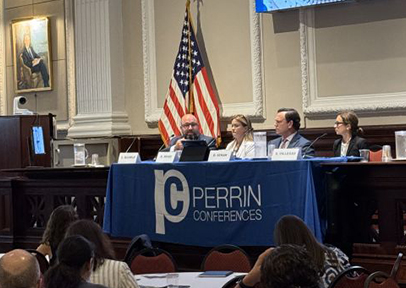Image courtesy of Perrin Conferences
BY: KRISTEN DRAKE
Perrin Conferences’ Environmental Risk and PFAS Litigation Conference, on June 17 and 18, 2025, at the New York City Bar Association, brought together an impressive cross-section of environmental attorneys, environmental specialists, and insurers, all focused on the evolving challenges of environmental liability, particularly in the context of PFAS.
I was honored to participate in the “How to Make an Allocation that Sticks” panel. It was a dynamic discussion, and I’d like to share a few key insights from the session, especially for those facing the daunting task of funding an environmental investigation and/or remediation.
Temporal Allocation: A Critical Component
One of the major themes I focused on was temporal allocation, how liability is divided across multiple insurance policies when contamination spans several years or decades. This is especially relevant in PFAS cases, where pollution may have occurred gradually and gone undetected for years.
Different approaches to temporal allocation include:
- Pro rata – time on the risk: Each insurer is responsible for a share of the loss proportional to the time their policy was in effect.
- All sums: The policyholder can choose any one policy in effect during the damage period to cover the entire loss, and that insurer may then seek contribution from others.
- Trigger theories: Courts may apply different theories (e.g., exposure, manifestation, continuous trigger) to determine when coverage is activated.
A well-structured temporal allocation can help maximize available coverage and ensure that no single policy or carrier is unfairly burdened.
Understanding how to allocate liability across time is essential for building a defensible claim and negotiating with insurers. It’s also where insurance archaeology becomes incredibly valuable.
The Power of Insurance Archaeology
At PolicyFind, we specialize in locating and reconstructing historical insurance coverage, even when original policies are lost or mislaid. During the panel, I shared how PolicyFind uses techniques to uncover evidence of coverage through broker records, corporate correspondence, accounting ledgers, legal filings, and more.
This kind of research can be a game-changer for clients who are facing environmental liabilities but don’t have the documentation they need to trigger coverage.
Why This Matters for PFAS and Beyond
PFAS litigation is accelerating, and many companies, municipalities, and property owners are finding themselves pulled into complex, high-cost cleanup efforts. What many don’t realize is that legacy insurance policies, written decades ago, may still provide coverage for these claims.
The key is knowing where to look, how to interpret the language of those old policies, and how to build a compelling case for coverage. That’s where collaboration between insurance archaeologists, legal counsel, and environmental consultants becomes essential.
Final Thoughts
This conference reinforced what PolicyFind sees every day in our work: environmental liabilities are growing more complex, but so are the tools used to address them. Historical insurance is one of the most underutilized assets in environmental litigation, and we’re passionate about helping clients unlock its potential.
If you’re facing environmental liabilities, whether related to PFAS, legacy contamination, or emerging pollutants, don’t forget the past. It might just hold the key to funding your future. Contact us today.

